- Army
- Air Defense Systems
- Anti-tank systems and vehicles
- Armored Vehicles
- Armoured personnel carriers
- Artillery Vehicles and Weapons
- Command Post
- Communication Vehicles and Systems
- Electronic Warfare
- Engineer | Maintenance Vehicles
- Infantry Fighting Vehicles
- Main Battle Tanks
- Missiles
- Tactical and Logistic Vehicles
- Radars
- Unmanned Systems
- Weapons
- Navy
- Air
BMP-1
BMP-1 IFV
Tracked Armoured Infantry Fighting Vehicle - Russia
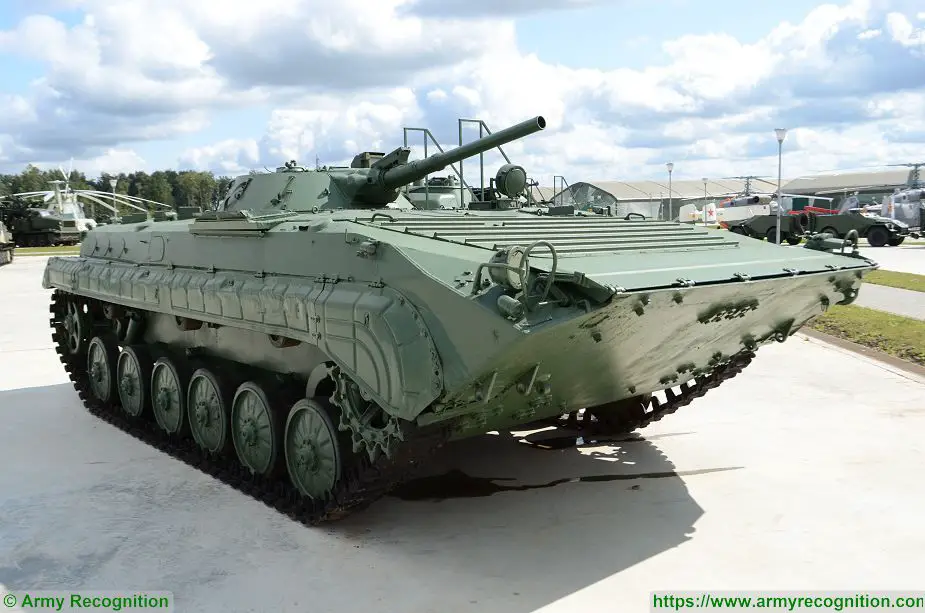
Description
The BMP-1 is a Russian-made tracked armored infantry fighting vehicle (IFV). The BMP-1 infantry fighting vehicle was adopted for service in 1966 by the Russian army. It is designed to carry the infantrymen, engage in combat, and support the dismounted infantrymen by fire when they fight on foot. By the mid-1960s, the infantry squad was armed with organic weapons to fight the enemy either from inside the vehicle or on foot after dismounting. For this purpose, an infantry fighting vehicle, designated BMP-1, was developed. The introduction of tactical nuclear weapons demanded a wider dispersion of troop formations on the battlefield without compromising the firepower of even small subunits. To solve the problem, infantry units must have been provided with their own fire support weapons. It was believed that the achievement of this objective would allow the world's first armored vehicle of this class. It possesses considerable firepower, high mobility, good armor protection, and survivability. It is capable of crossing water obstacles without any preliminary preparation. The BMP-1 infantry fighting vehicle is in service with many armies around the world. It showed its worth in action in numerous regional conflicts. Taking into consideration the increasing requirements for the effectiveness of infantry fighting vehicles, the Russian defense industry is currently involved in modernizing the existing fleet of the BMP-1. After modernization, they will be more effective operationally and come close in terms of their performance characteristics to the next generation of infantry fighting vehicles.
BMP-1 variants:
- BMP-1F: reconnaissance model used by Hungary
- BMP-1K: command post version
- BMP-1K3: command post version
- BMP-1P: with AT-4 9M114 ATGW and 81 mm smoke grenade launchers
- BMP-1PK: command post version of BMP-1P
- BRM-1: reconnaissance version
- BRM-1K: basic reconnaissance version with a two-man turret
- BMP-1KShM: unarmed command variant
- PRP-3: with a two-man turret and a radar at the rear
- PRP-4: This is a further development of the PRP-3 and has an additional housing on the left side of the turret for an electro-optical device similar to that on the right side
- BWP: Polish designation for basic BMP-1
- IRM: It has been designed to undertake a variety of specialized engineer reconnaissance roles including mine detection with two devices mounted at the front of the vehicle which can be retracted flush with the front of the hull when not required.
- RTV: repair tracked vehicle with a crane
- BMP-PPO: mobile training vehicle with its turret removed and fitted with eight roof-mounted cupolas for trainees under instruction, plus seats for the vehicle commander and driver.
- IV31 or BMP-1 MP-31: command and staff vehicle for air defense units. It is equipped with two radios R-111, an R-159, R-123MT and R-130M and has the same HAWK EYE antenna as the similar BMP-1KShM. It is distinguished by a much larger generator. The MP-21-R-1 (an MT-LBu) is the successor to the MP-31. The 9S743, also known as the BMP-1KShM-9S743 (Bulgaria) is similar, but has a large storage box on the right side of the generator instead of the two smaller ones left and right
- BREM-4: recovery version, this is the Russian designation for the Czech VPV or BREM-Ch
- BREM-2: recovery version
- MLI-84: Romanian-built BMP-1 IFV.
- BMP-1AM: a modernized version of the standard BMP-1 but fitted with a new remotely operated weapon station armed with one 2A72 30 mm automatic cannon, a Kalashnikov PKTM 7.62 mm coaxial machine gun. The turret can be also armed with one ready-to-use Metis-family ATGM (Anti-Tank Guided Missile), probably, the 9M115 Metis (AT-7 Saxhorn) or 9M131 Metis-M (AT-13 Saxhorn-2) missile
Technical Data
| Armament |
|
The BMP-1 is fitted with a one-man turret. The main armament of the BMP-1 IFV is a 73 mm Model 2A28 smoothbore, low-pressure, short-recoil gun which weighs 115 kg. This is fed from a 40-round magazine to the right rear of the gunner. A 7.62mm PKT machine gun is mounted coaxially to the right of the main armament. Mounted over the main armament is a launcher for a Kolomna KBM 9K 11 Malyutka AT-3 'Sagger' wire-guided ATGW. One missile is carried in the ready to launch position with a further two missiles in the turret, these are loaded via a rail through a hatch in the forward part of the turret roof. A further two missiles are carried in the hull.
|
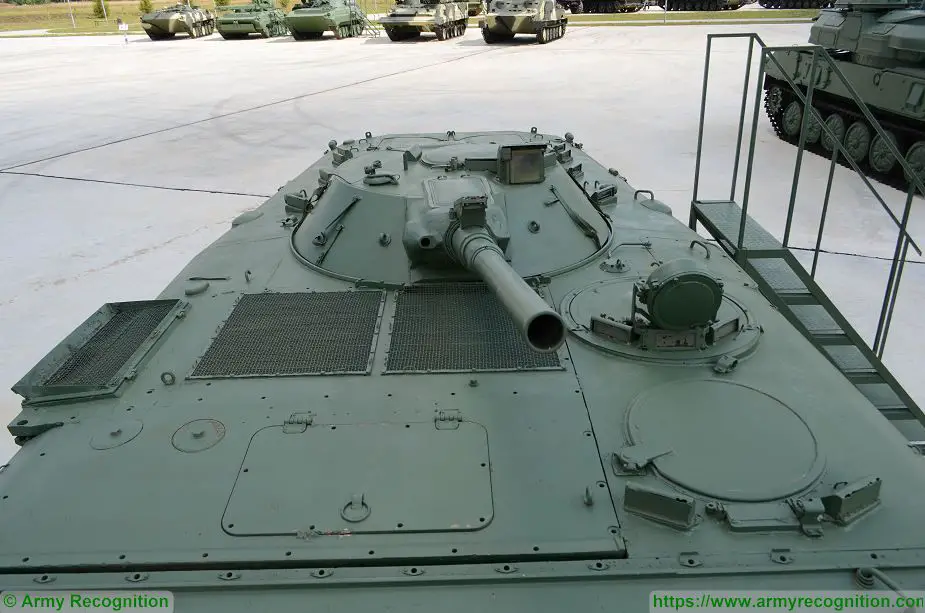 Close view of BMP-1 one-man turret armed with one 73mm cannon Close view of BMP-1 one-man turret armed with one 73mm cannon |
| Design and protection |
|
The hull of the BMP-1 IFV is made of all-welded steel which provides the crew with protection from small arms fire and shell splinters. According to Russian information, the armor of BMP-1 provides complete protection against 12.7 mm over the front of the hull. The driver sits at the front of the hull on the left side and has a single-piece hatch cover that opens to the right. The commander is seated behind the driver and has a cupola that can be traversed through a full 360º. The troop compartment is at the rear with the eight infantrymen seated back-to-back, four down each side of the hull. They enter and leave by two doors in the rear of the hull which has integral fuel tanks (60 liters in the left door and 70 liters in the right) and is hinged on the outside. Each door has a day vision device and the left door has a firing port. Over the top of the hull are four roof hatches, two on each side, which are hinged in the center and can be locked vertically. There are four firing ports in each side of the hull and four heated day periscopes on each side of the roof for aiming.
|
| Mobility |
| The BMP-1 suspension of either side consists of six rubber-tired road wheels with the drive sprocket at the front, idler at the rear, and three track return rollers. The first and last road wheel stations have a hydraulic shock-absorber and the top of the track has a light sheet steel cover, which is normally removed when operating in snow. The engine and transmission are to the right of the driver's and commander's positions with the steering system at the front of the hull. The air inlet and outlet louvers are in the top of the hull. The BMP-1 is motorized with a Type UTD-20 6-cylinder in-line water-cooled diesel developing 300 hp at 2,000 rpm coupled to a manual transmission with 5 forward and 1 reverse gears. |
| Accessories |
| The BMP-1 is fully amphibious being propelled in the water by its tracks at a maximum speed of 7km/h. Before entering the water the trim vane, which is stowed on the glacis plate of the vehicle when not in use, is erected at the front of the hull, the bilge pumps are switched on, and the driver's center day periscope is replaced by an extensible day one to enable him to see ahead over the trim vane. The BMP-1 can make its own smoke screen by injecting vaporized diesel fuel into the exhaust manifold using the TDA engine thermal smoke generating system. A number of BMP-1s were fitted with mountings for the KMT-10 plow-type of the mine-clearing system in the early 1980s. The BMP-1 is equipped with an NBC protection system to protect the crew and the soldiers from chemical weapons, biological agents and nuclear fallout by air filtration and overpressure system which consists of the NBC filter element and the blower/dust separator. |
Specifications
| Armament | Armor |
| One 73mm 2A28 gun, one PKT 7.62mm machine gun, 1 launcher rail for Anti-tank guided missile AT-3 Sagger | Protection against small arms and shell splinters. |
| Country users | Weight |
| 42 countries in the world | 13,500 kg |
| Designer Country | Speed |
| Russia | 65 km/h maximum road speed, 7 km/h on water |
| Accessories | Range |
| Infrared night vision, NBC protection system, fully amphibious | 550 - 600 km |
| Crew | Dimensions |
| 3 + 8 infantrymen | Length: 6.74 m; Width: 2.94 m; Height: 2.15 m |
Details View
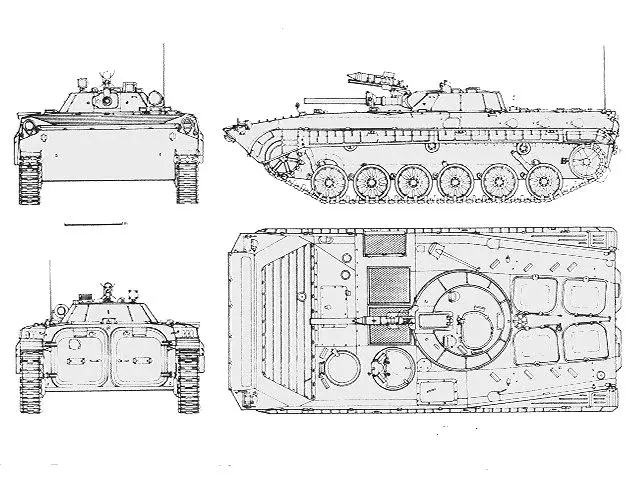 |
|
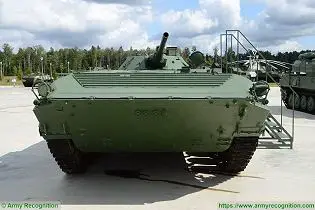 |
 |
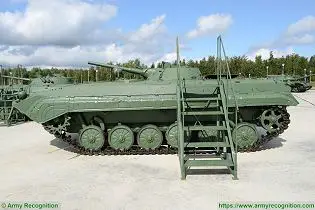 |
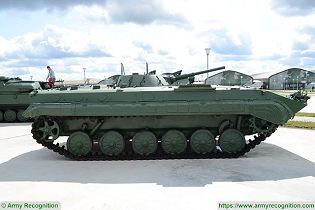 |
Pictures - Video



























